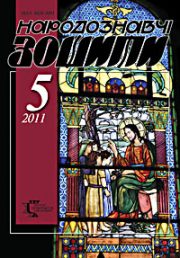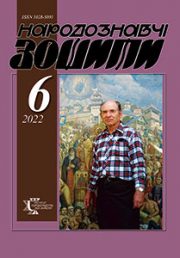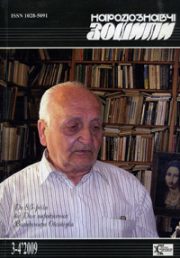The Ethnology Notebooks. 2023. № 5 (173), 1216—1225
UDK 392.8-056.253(=161.2):811.161.2’28’373.2:341.485(47+57:477)”1932/1933″
DOI https://doi.org/10.15407/nz2023.05.1216
SHEREMETA Liliia
- ORCID ID: https://orcid.org/0000-0003-2972-9578
- Methodist,
- National Museum of the Holodomor-Genocide,
- 3, Lavrska Str., Kyiv, Ukraine,
- Contacts: e-mail: lilyok3@ukr.net
Abstract. The Holodomor of 1932—1933 is recognised as a genocide of the Ukrainian nation that resulted in grave and prolonged consequences that Ukrainians still feel in all spheres of life. Our nation has been affected on mental, moral and psychological, spiritual, cultural and educational, and other levels. The violation of the traditional food culture of Ukrainians can be traced during the years of the Holodomor-genocide, when the communist totalitarian regime, taking away all food supplies from Ukrainians, forced them to eat surrogate food, weeds, carcass meat, and often even human flesh. In 1932—1933, new names for dishes appeared; the composition, recipe, ingredients, and specifics of cooking traditional Ukrainian dishes were also changing. This is typical for the entire territory of Ukraine at that time.
The purpose of the article is to analyse the memories of the Holodomor-genocide eyewitnesses from various regions of Soviet Ukraine, to reveal common and different food products, names of dishes, their ingredients, and, if possible, recipes and specificities of cooking.
The scientific novelty. The research analysed the names and composition of dishes that Ukrainians cooked during the Holodomor of 1932—1933 in order to survive. On the basis of the memories of the Holodomor-Genocide eyewitnesses from various regions of Soviet Ukraine, common and different food products, names of dishes, their features, and recipes are revealed.
The author of the article comes to a conclusion in each region, that Ukrainians had different names for dishes cooked from the same products. People used both well-known names to designate traditional daily dishes (borshch, soup, yushka, zatirka, halushky, etc.) and gave them new, individual names (rozbombokha, tonika, lepianyky, lypnyky, lepantsi, lobodapyky, pletsyky, malymony, etc.). The dishes of Ukrainians can be divided into the following groups: 1) first (liquid) dishes: balanda, bevka, borshch, burda, zatirka, green borshch, kandior, laturka, pokhliobka, liquid dish, soup, yushka; 2) second (main) dishes: porridge (mamalyha corn porridge, neshchymna porridge), kulish, formuha (farmuha); 3) baking: balabukhy, balabushky, buhantsi, deruny, casseroles, potato cakes, korzhyky, korzhi, ladyky, ladky, lypianyky, lepantsi, liepioshky («officers», «mordoplioty»), lipioshychky, lobodapyky, lobodianyky, lypnyky, malai, corn cakes, labety, pancakes, malymony, oladky, pampushky, pletsyky, pliatsyky, pliatsky, bread, loaves; 4) dessert: kysil, honey, tea, yahodianka, decoction, uzvar. The communist totalitarian regime caused the destruction of the traditional food culture of Ukrainians.
The research methodology is based on general scientific methodological principles and the main requirements for works of historical and ethnological direction.
Keywords: Holodomor, genocide, 1932—1933, food, non-traditional dishes, surrogate food.
Received 20.09.2023
REFERENCES
- Hlushko, M., & Makarchuk, S.A. (Ed.). (2015). Folk сuisine. Etnohrafiia ukraintsiv: navch. posibn. (Pp. 347—368). Lviv: LNU im. I. Franka [in Ukrainian].
- Markova, S., & Sheremeta, L.(2021). Ukrainian peasant breadwinner: historical and etymological discourse. Ukrainskyi selianyn (Issue 25, pp. 115—121) [in Ukrainian].
- Braichenko, O. (2017). Culture of food consumption in Ukraine in 1920s and 1930s: trends and changes. Etnichna istoriia narodiv Yevropy: zbirnyk naukovykh prats (Issue 53, pp. 107—114). Kyiv [in Ukrainian].
- Petrova, N. (2018). Deformation of the traditional food system of Ukrainians during the Holodomor. Italian food in history and culture: a collection of scientific articles on the year of Italian food in the world (Pp. 119—134). Odesa [in Ukrainian].
- Artiukh, L. (1999). Folk nutrition, food, kitchen utensils. Ukrainians. Historical and ethnographic monograph (Vol. 2, pp. 121—138). Opishne [in Ukrainian].
- Kotsur, Yu. (2011). Nutrition of the population of Romania at the beginning of the 30s of the 20th century. Etnichna istoriia narodiv Yevropy: zbirnyk naukovykh prats (Issue 34, pp. 55—64). Kyiv [in Ukrainian].
- Vavrynchuk, M.P., & Markova, S.V. (2008). The struggle of Podil peasants for survival: «food» of a peasant family during the years of genocide. Holodomor 1932—1933 rokiv na Khmelnychchyni: prychyny i naslidky (Pp. 115—127). Khmelnytskyi [in Ukrainian].
- Bondarenko, M. (2018). Ukraine 1933: a cookbook. The memory of the people. Sumy: Ellada [in Ukrainian].
- Riznykiv, O. (2003). Food of 1933. Holodomor Dictionary. Odesa: Iurydychna literatura [in Ukrainian].
- Markova, S., & Sheremeta, L. (2020). Life trauma of victims of the Holodomor-genocide: historical and psychological aspects of the «untraditional» diet of Ukrainians. Ukrainskyi selianyn (Issue 24, pp. 24—28) [in Ukrainian].
- Shvets, V.K. (2008). Ukrainian famine: facts, consequences, research: witness testimonies collected by students (P. 14). Nizhyn: PP Lysenko [in Ukrainian].
- Borysenko, V.K. (2007). A candle in remembrance: an oral history of the Ukrainian genocide in 1932—1933. Kyiv: Stylos [in Ukrainian].
- Bliednov, S. (2008). Holodomor in Donbas (1932—1933): Author’s contemplation, testimonies, documents. Donetsk: Donbas [in Ukrainian].
- Bliednov, S.F. (2008). Resurected memory. Telmanove district of Donetsk region. Historical sketch, testimonies of the district residents, documents, commemoration of the Holodomor victims. Seriia knyh «Hirka pam’iat». Donetsk: Rehion; SPD Bliednov [in Ukrainian].
- Derzhavnyi arkhiv Donetskoi oblasti. F. 326. Op. 1. Spr. 130 [in Ukrainian].
- Bliednov, S.F. (2008). The memorable. Marinka district of Donetsk region. Historical sketch, testimonies of the district residents, documents, commemoration of the Holodomor victims. Donetsk: Rehion; SPD Bliednov [in Ukrainian].
- Bliednov, S.F. (2008). Flame of memory. Velyka Novosilka district of Donetsk region. Historical sketch, testimonies of the district residents, documents, commemoration of the Holodomor victims. Seriia knyh «Hirka pam’iat». Donetsk: Rehion; SPD Bliednov [in Ukrainian].
- (2014). The echo of calamity. Memories of witnesses of 1932—1933 and 1946—1947 Holodomors, as well as the period of Nazi occupation, recorded by students of the History Faculty of I.I. Mechnikov ONU. Odesa [in Ukrainian].
- Harkusha, O.M., & Shytiuk, M.M. (Eds.). (2008). The National Memory Book of Holodomor victims of 1932—1933 in Ukraine: Mykolaiv region. Mykolaiv: Shamrai [in Ukrainian].
- Bilousova, L.H., Baranovska, O.M., Volkova, T.Ye., & Malinova, H.L. (2005). Holodomor in Ukraine. Odessa region (1921—1923, 1932—1933, 1946—1947). Memories, documents, research. Odesa: Chornomor’ia [in Ukrainian].
- Dorosh, M. (2003). Broken spirelets. Publicism. Documents. Vinnytsia: Veles [in Ukrainian].
- Havchuk, I.K., Hladuniak, I.V., Slobodianiuk, P.Ya., & Osadcha H.H. (2 eds.). (2008). The National Memory Book of Holodomor victims of 1932—1933 in Ukraine: Khmelnytskyi region (Part 1). Khmelnytskyi [in Ukrainian].
- Dorosh, M. (2007). Black mowing. Publicism. Documents. Vinnytsia: O. Vlasiuk [in Ukrainian].
- Romanets, N.(2020). Holodomor-genocide of 1932—1933 in the Dnipropetrovsk region: scale, consequences: a collection of documents. Dnipro [in Ukrainian].
- Mykhailova, S. (2021). Reasons and factors of moral and psychological destruction of witnesses of the Holodomor of 1932—1933. Mizhdystsyplinarni pidkhody u doslidzhenni Holodomoru-henotsydu: materialy IV Mizhnarodnoi naukovo-praktychnoi konferentsii (19 lystopada 2020 r.) (Pp. 108—111). Kyiv [in Ukrainian].







